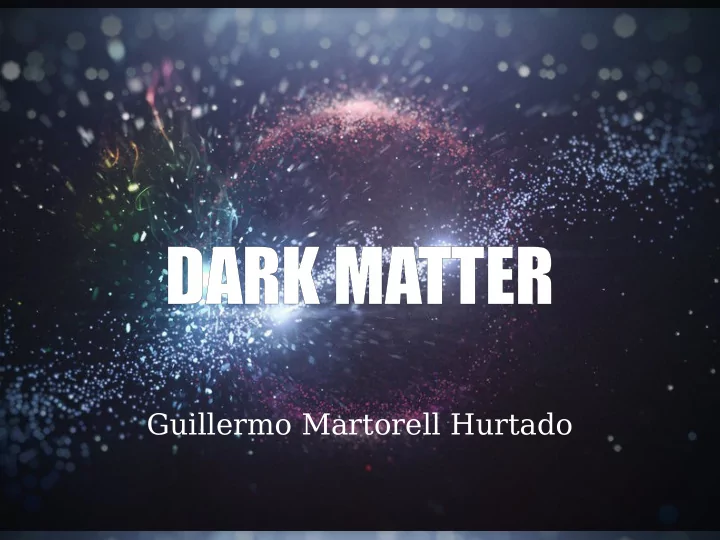

DA DARK RK M MATTER TTER Guillermo Martorell Hurtado
¿What is it? ● Necessary to explain the dynamics of the rotation of celestial bodies Fritz Zwicky Vera Rubin ● (Obviously) Invisible: does not emit photons ● Not included in the Standard Model ¡WE DON'T KNOW WHAT IT IS! BUT THERE ARE CANDIDATES
WIMPs ● Candidate of Dark Matter ● Weakly Interactive Massive Particles ● Very massive particles, purely experiment gravitational effects, that's what makes detection extremely difficult ● They gather in massive celestial bodies: Sun, Earth, Galactic Centres, Dwarf Spherical Galaxies... ● They collide and annihilate ● Move slowly
WIMP-WIMP Annihilation Leptons, quarks, bosons. ? (unstable) SM ¡NEUTRINO!
To Detect Neutrinos... KM3NET ANTARES
Data Analysis ● We start with two simulation data: one of neutrino (isotropical) and other with atmospheric neutrinos ● Our aim is to start from the simulation to obtain “filters” or “cuts” that will allow us to delete effectively the background (or noise) and apply thos methods to real data, with the objective of obtaining concluding results (enough evidence to be a “discovery”). ● PROBLEM: very small signal over a large background
FIRST “ROUGH” FILTER θ In order to distinguish between neutrino and atmospheric muons, we need to “block” all that comes from “above the earth” (theta between 90 and 180 degrees).
NEXT STEP: Signal filters ● In order to distinguish between signal neutrino (who come from a certain source) and background neutrino, we need to apply more filters to the remaining neutrino simulated data ● Energy spectrum-> Apply weights (depending on what we want to see and the theoretical model)
SKYMAP PARTICLE PHYSICS ASTRO- PHYSICS PPROBABILITY TEST DISTRIBUTIONS: STATISTICS - BACKGROUND - SIGNAL In the end, all we try to do is see the way that our simulation (which we consider to reflect the reality) behaves, and if we observe something similar in our data, then we MAY see if we have detected a source. Okay, but one thing...
¿Where's the real data? π
Opening the data ● Now it is time to open our data! ● Then is when we perform an analysis of the data with all the parameters that we have set before, and run a “Test Statistics” on the data. ● If the result of all of that process seems to be consistent with the signal distribution (there is no evidence to reject that we have found a source), then we can say we have succeded! ● The result, however, seems to be negative or inconclusive most of the times
WHAT HAPPENS WITH THE DATA? THE DATA IS DESTROYED
Recommend
More recommend